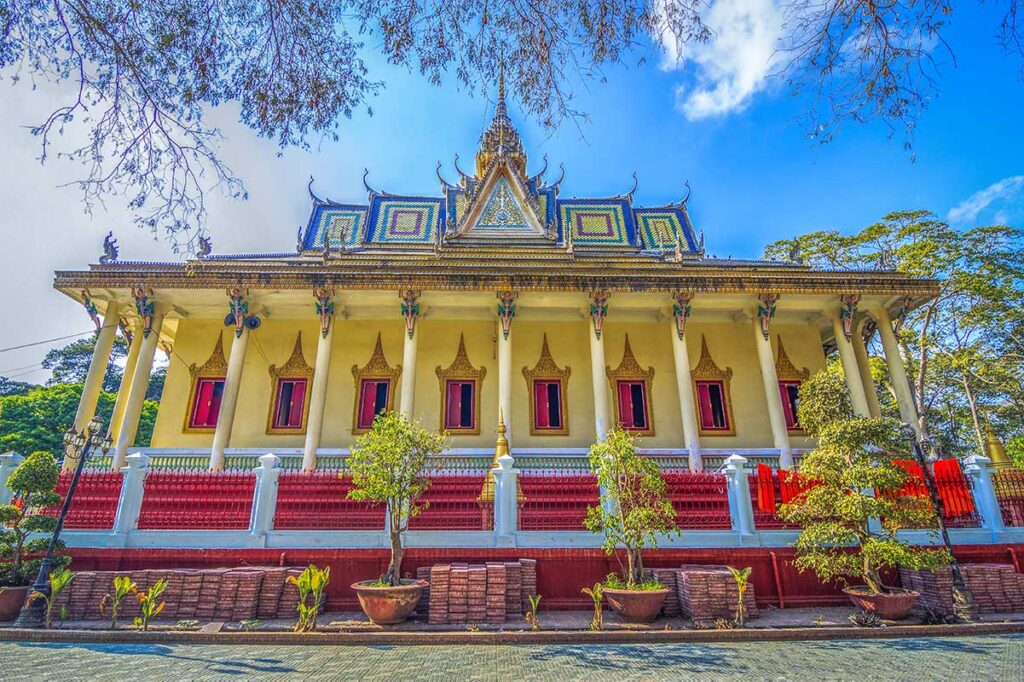What is Hang Pagoda (Cave Pagoda)?
Hang Pagoda, locally called Chùa Hang or Kompong Chrây Pagoda, is a Khmer Theravada Buddhist temple just outside Tra Vinh Town. It’s not the largest or most famous pagoda in Vietnam, but it has a mix of features that make it stand out: centuries-old Khmer architecture, a bird sanctuary with thousands of storks and herons, and a small wood-carving workshop where monks and artisans create intricate sculptures.
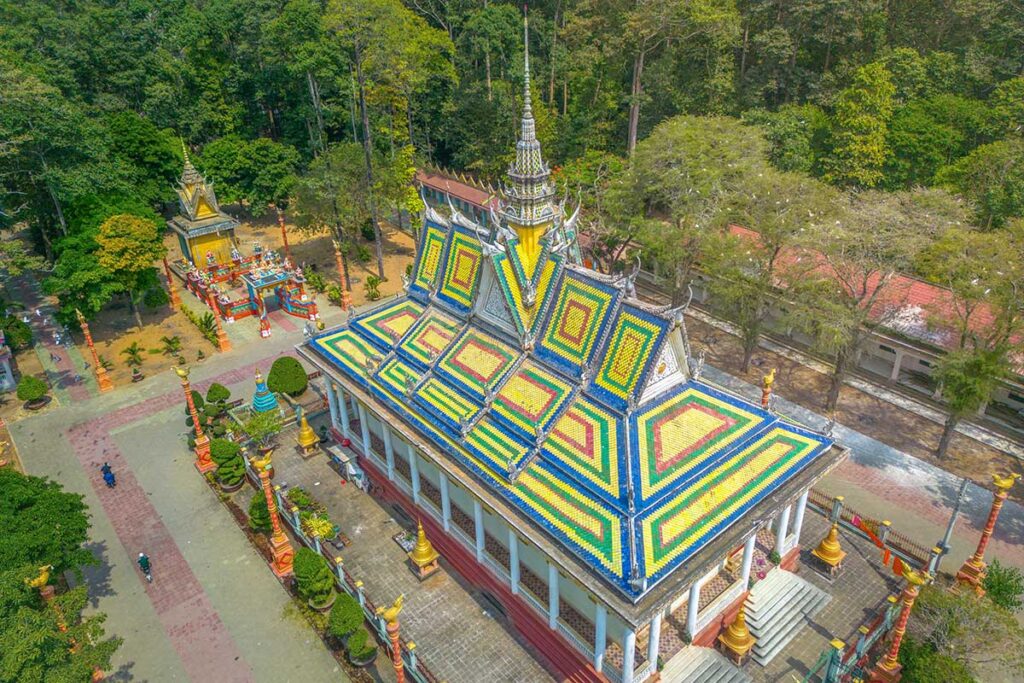
For the Khmer community in Tra Vinh, the pagoda is both a place of worship and a cultural hub, while for visitors it offers a chance to experience Khmer religious life in a natural setting. Surrounded by tall trees and shaded paths, the grounds feel more like a forest than a typical temple complex, which adds to its character. Located just 6 km from the center of Tra Vinh, it’s one of the easiest cultural stops to add to a trip through the province.
History of Hang Pagoda
Hang Pagoda was founded in 1637 by the local Khmer community and originally carried the name Wat Kompong Ch’ray, meaning “Banyan-tree Wharf.” The name reflects its location along the river, where a banyan once shaded the old boat landing used by villagers traveling to the temple for worship. From the beginning, it has been a Khmer Theravada Buddhist center, serving both spiritual needs and cultural education for the community.
Like much of Tra Vinh, the pagoda was caught in the turmoil of the Vietnam War. During the 1968 Tet Offensive, it suffered heavy damage from bombings and gunfire. Almost a decade later, in 1977, monk Thach Suong returned to rebuild it, and under his guidance the temple gradually recovered and expanded.
Today, Hang Pagoda continues to function as a religious, cultural, and educational hub. It remains important for Khmer Buddhist rituals, while also housing a school and community spaces that help preserve Khmer traditions, language, and arts. For visitors, its history adds depth to what might otherwise feel like just another temple stop.
Highlights of visiting Hang Pagoda
1. The Cave-Like Entrance Gate
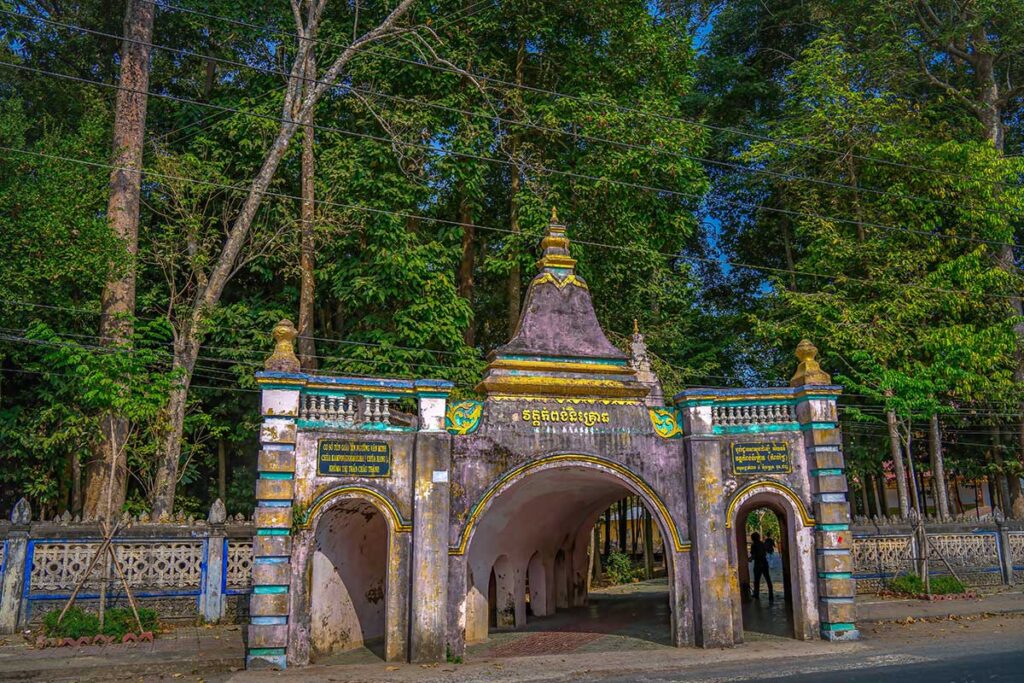
The first thing that sets Hang Pagoda apart is its unusual entrance. Instead of a standard open gate, you pass through an arched structure built to resemble three adjoining caves, with thick 12-meter walls that give it a solid, almost fortress-like feeling. This “cave gate” not only explains the temple’s nickname but also ties back to Brahmanic and early Khmer Buddhist traditions, where caves were places of meditation and retreat.
Flanking the entrance are large guardian statues known as Yaks—figures once considered demons but later converted into protectors of the Buddha. Carvings of the naga, the multi-headed serpent, add another layer of symbolism connected to Buddhist teachings.
2. The Main Hall and Architecture
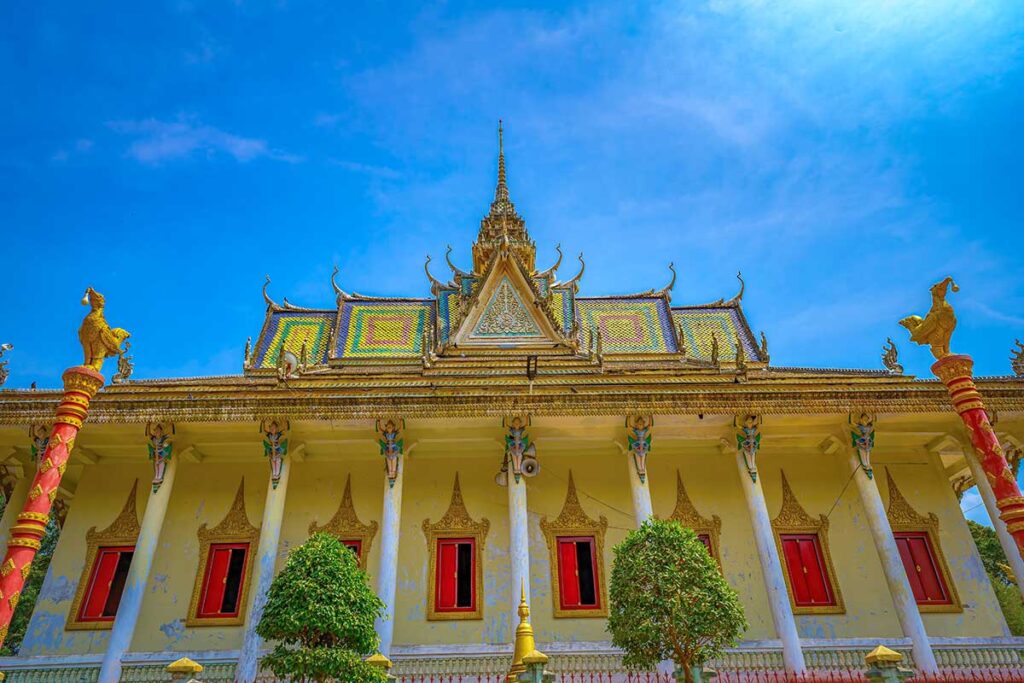
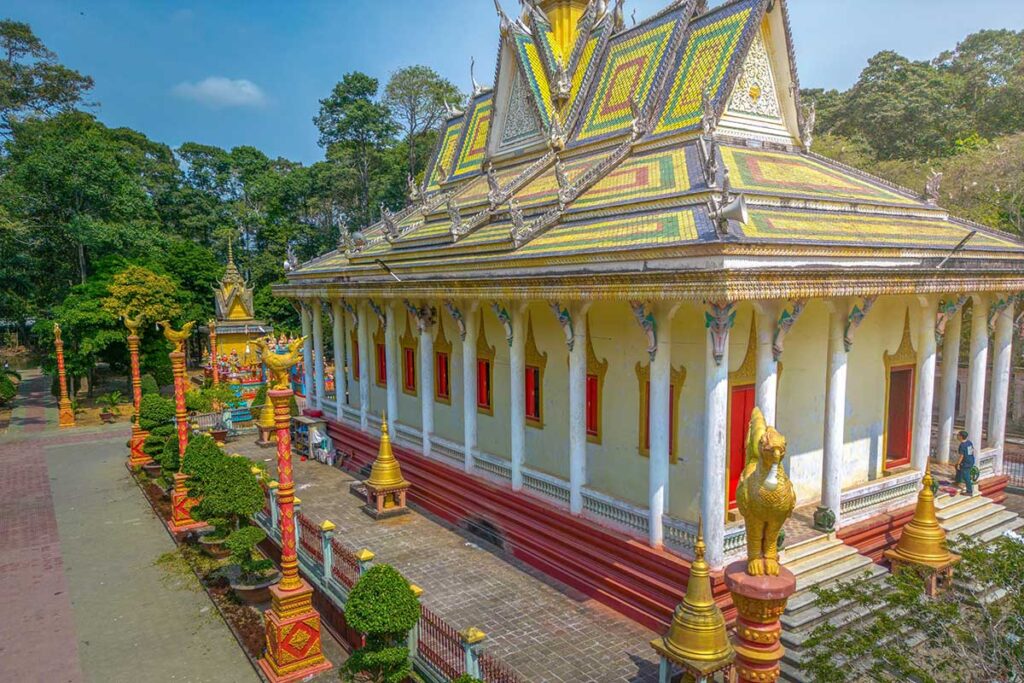
The main hall stands elevated above the surrounding grounds, reached by a flight of stairs. Its layered roof and central tower are classic features of Khmer architecture, while the walls and pillars carry detailed motifs. Inside, the focal point is a large statue of Shakyamuni Buddha, accompanied by smaller figures in different poses.
Around the exterior, you’ll notice naga reliefs, the 12-spoke wheel symbolizing the Buddhist teaching of dependent origination, and animal statues that reflect both Khmer mythology and Buddhist cosmology. The design feels both imposing and artistic, even if you’ve seen other Khmer temples in the region.
3. Bird Sanctuary
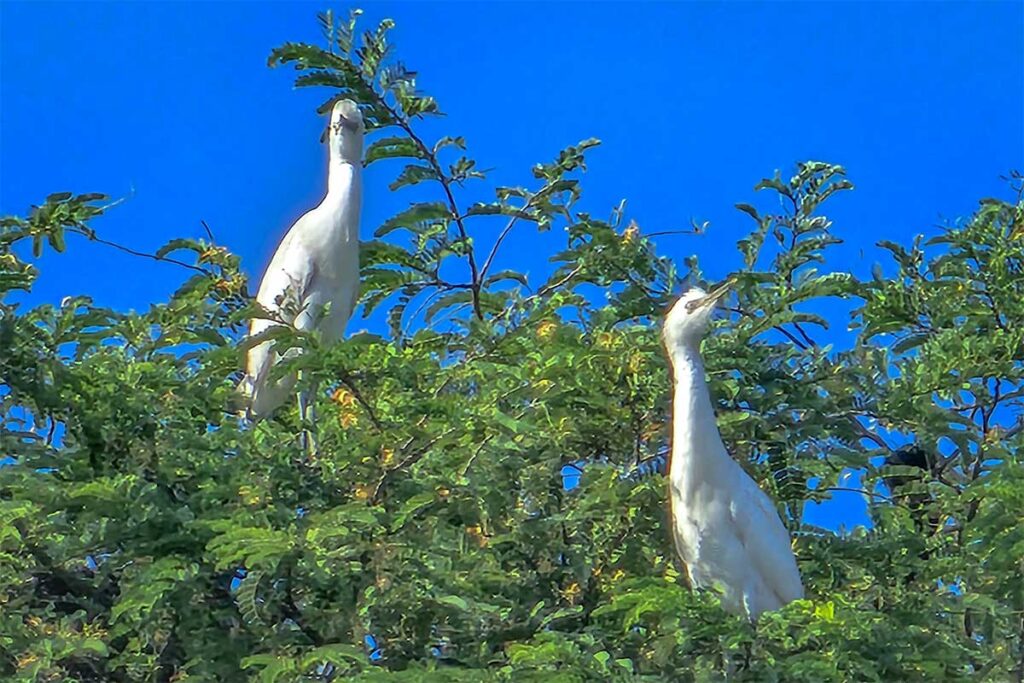
One of the most distinctive features of Hang Pagoda is its role as a sanctuary for birds. Thousands of storks, herons, and other species nest in the tall trees around the grounds. Early in the morning and late in the afternoon, the air fills with their comings and goings, creating a lively and sometimes chaotic atmosphere.
For many visitors, it’s a fascinating sight; for others, the sheer number of birds means dealing with noise, droppings, and an occasional strong smell. It’s beautiful and messy at the same time, but that’s part of the reality here.
4. Wood-Carving Workshop
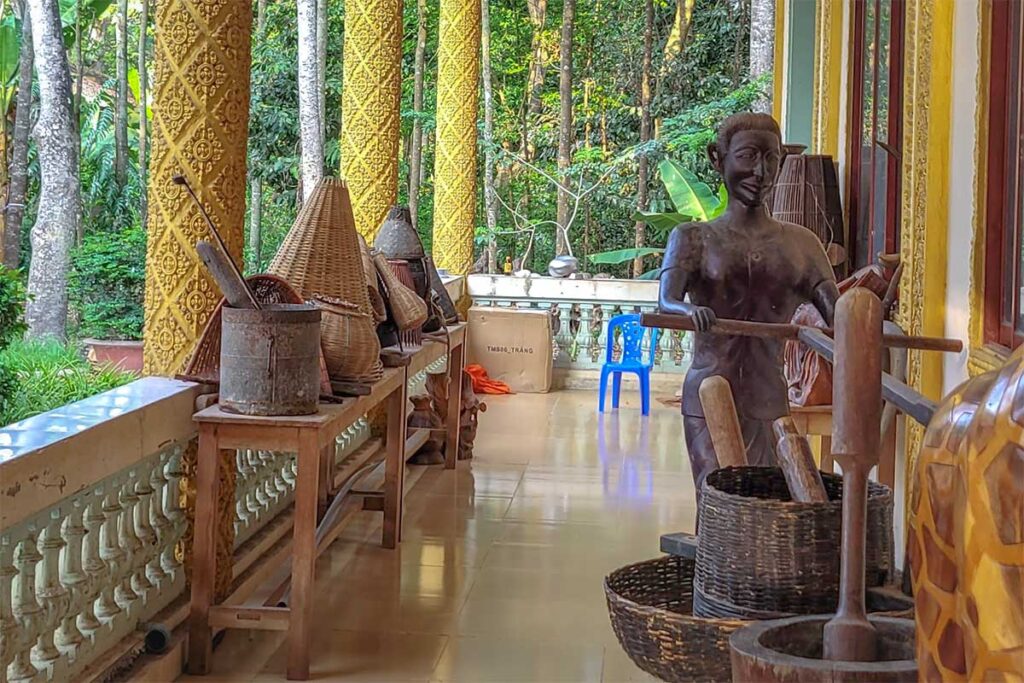
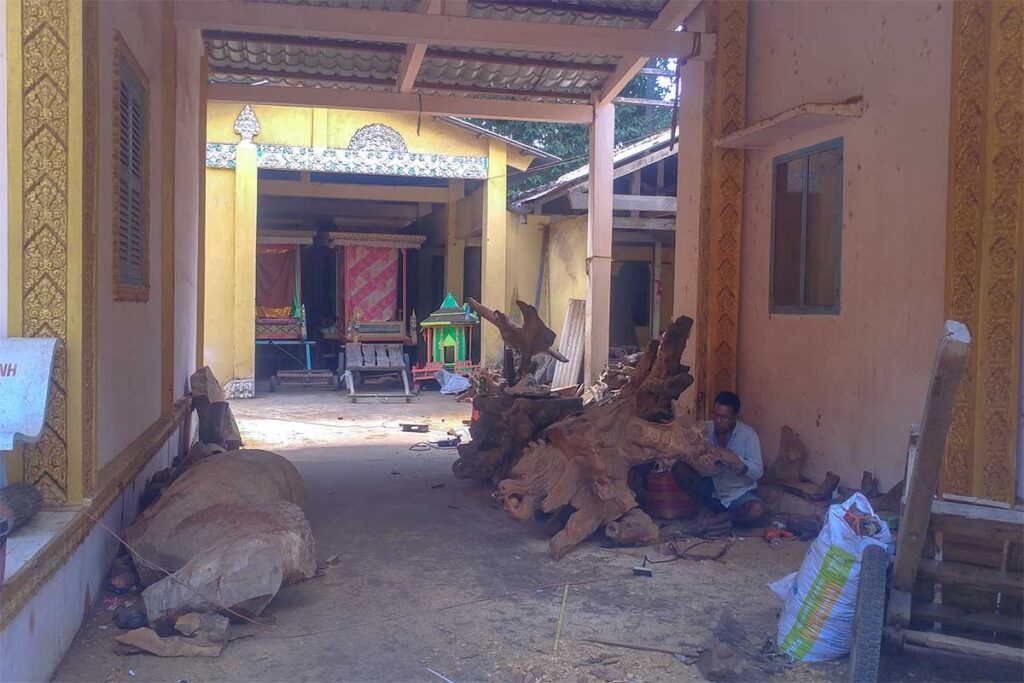
Within the pagoda grounds is a workshop that has been active for nearly three decades. Here, monks and local artisans craft intricate sculptures from tree roots and other wood, continuing a Khmer tradition of fine carving. The pieces range from religious figures to decorative art, and while it’s not a large workshop, it adds another dimension to the visit. If you’re interested in craftsmanship, watching the process can be as rewarding as seeing the finished works.
5. Forested Grounds and Tranquil Setting
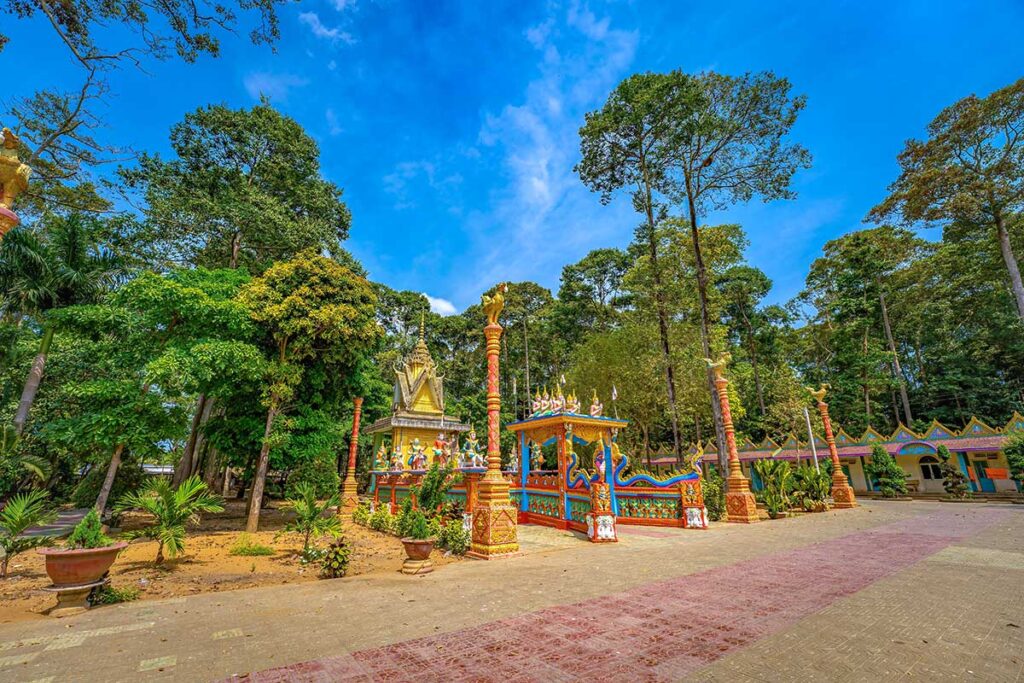
The compound covers an impressive 7–12 hectares, much of it shaded by bamboo, star wood, and other native trees. Walking the grounds often feels more like exploring a park or a patch of natural forest than a typical pagoda. The greenery keeps the area relatively cool, even in the heat of the day, and creates a tranquil atmosphere that contrasts with the busy birdlife overhead.
6. Cultural and Community Role
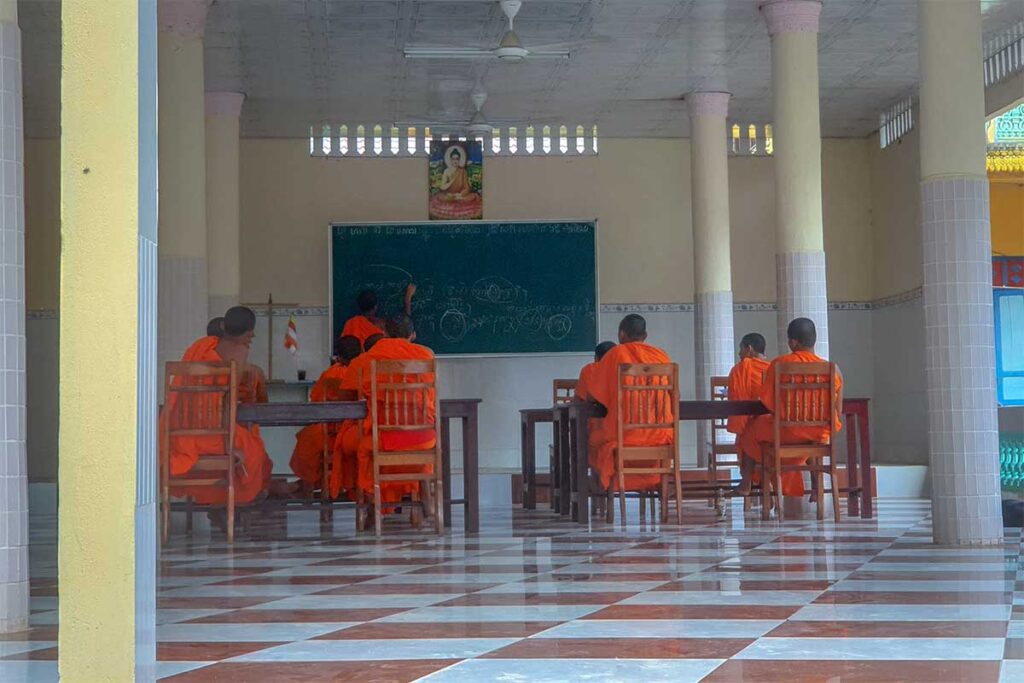
Beyond the religious and natural aspects, Hang Pagoda is an important community center for the Khmer in Tra Vinh. On the grounds you’ll find monks’ stilt houses and a school where children study Khmer language and Buddhist teachings. The pagoda plays an active role in preserving traditions and passing them on to the next generation. For visitors, this is a reminder that the site isn’t just for sightseeing—it’s a living part of Khmer cultural and spiritual life.
Location and How to get there
Where is Hang Pagoda?
Hang Pagoda sits about 6 km south of Tra Vinh Town, making it one of the most accessible sights in the area. It’s roughly a 2-hour drive from Can Tho and about 3 hours from Ho Chi Minh City, though in both cases it makes little sense to come just for the pagoda alone. The best way to visit is as part of a wider exploration of Tra Vinh province, where Khmer culture, countryside scenery, and other temples can easily fill a day or more.
How to Visit
- From Tra Vinh Town: The simplest option is a short motorbike or bicycle ride. Local roads are flat, shaded, and relatively quiet, making it an easy trip.
- From Can Tho: Hire a private car with driver or book a private tour that includes Hang Pagoda along with other Tra Vinh stops such as Ba Om Pond or Khmer pagodas. This saves time and avoids having to worry about navigation.
- Motorbike: If you’re comfortable riding, you can rent a scooter in Can Tho or Tra Vinh. The roads are manageable but still require some experience, as traffic rules can feel informal.
- Cycling: From Tra Vinh Town, cycling is a pleasant way to reach the pagoda and explore nearby countryside. Coming all the way from Can Tho, however, is only realistic for experienced cyclists with proper gear.
- Tours: You can do a private tour to Tra Vinh with an English-speaking guide. These usually combine Hang Pagoda with other cultural and nature sites, which makes the trip more worthwhile if you’re coming from outside the province.
Practical visiting information & Tips
Opening hours & Entrance fees
Hang Pagoda is open daily from dawn to dusk. Entry is free.
Dress code & Etiquette
As with other Khmer pagodas, modest clothing is expected—cover your shoulders and knees, and avoid anything too revealing. The grounds include sacred animal statues, so don’t let children climb on them. Donations are not required, but leaving a small contribution is a respectful gesture if you’d like to support the upkeep of the temple.
Best time to visit
Early morning and late afternoon are the most rewarding times to visit, both for cooler temperatures and for the spectacle of birds leaving or returning to their nests. The dry season (November to April) makes walking around and photography easier, though the pagoda is open year-round.
Things to expect
The atmosphere is generally calm and shaded, and even at midday the tree cover keeps it relatively cool. That said, the bird population means you may encounter strong smells and a fair amount of droppings, which can be off-putting for some.
Nearby attractions to combine
Hang Pagoda is best visited alongside other sights in Tra Vinh:
- Ba Om Pond (6 km): A scenic lotus pond with cultural significance.
- Vam Ray Pagoda and Nodol Pagoda (Stork Pagoda): Other Khmer temples worth seeing.
- Truc Lam Zen Monastery and the Khmer Museum: Good options for learning more about local culture.
- Con Chim Islet: A small community-based tourism project that showcases Mekong Delta village life.
You can read our full Tra Vinh travel guide with more sights and it includes in itinerary to combine most of these sights in a day.
Is Hang Pagoda worth visiting?
If you’re already in Tra Vinh, Hang Pagoda is definitely worth a visit. It’s close to town, easy to reach, and offers a good mix of Khmer architecture, cultural insight, and the unusual experience of walking through a bird-filled temple forest.
Coming from Can Tho, it’s still worthwhile, but best if you combine it with other Tra Vinh highlights like Ba Om Pond or nearby Khmer pagodas. On its own, the trip might feel a little underwhelming.
